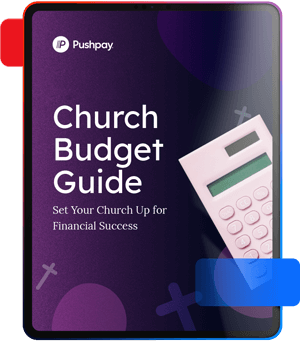What Should Your Church’s Year End Giving Statement Include?
January 30, 2024 |
As the year draws to a close, it’s time for your church to reflect on the past twelve months. You’ve hosted events, preached sermons, and gathered donations, all in an effort to faithfully fulfill your mission. And now, it’s time to celebrate all you’ve accomplished and thank those who fueled your ministry with year-end giving statements.
Each donation your church receives plays a part in supporting ministries and driving community outreach initiatives. So when your members see their contributions listed on a giving statement, they can truly appreciate how their generosity has helped the church fulfill its mission. Contribution statements aren’t just pieces of paper or digital documents.
They’re a tangible acknowledgment of the generosity of your congregation.
They say “thank you” for every contribution, whether big or small.
They ensure transparency and accountability in the church’s financial matters.
And they serve as an affirmation of the impact of your donor’s gifts throughout the year.
Ready to start creating this year’s giving statements? Keep reading for recommendations on what to include and a free guide to ensure your statements make a statement.
Essential Elements of a Year-End Giving Statement
One of the most critical components of an end-of-year giving statement is the detailed breakdown of financial contributions. Here’s why it’s so important and what you need to include:
Detailed Financial Contributions
Your congregation members aren’t just donors but partners in your mission. They’ve committed to supporting your church and deserve to see exactly how they’ve done that over the past year. So, it’s essential to provide a comprehensive list of individual donations along with their specific dates.
Listing Individual Donations and Their Dates
Each donation made by a member represents a moment of generosity—a decision to invest in the work of the church. As such, it’s crucial to acknowledge every one of these instances. By listing each donation with its date, you’re not only providing a complete financial record but also reminding your members of the times they stepped up to support your church’s mission throughout the year.
Importance of Accuracy and Clarity
Accuracy and clarity are non-negotiable when it comes to your year-end giving statements. Mistakes or confusion can lead to mistrust and frustration, undermining your relationship with your congregation. Furthermore, accurate reporting is vital for maintaining data integrity across all systems, a key concern for finance directors and executive pastors alike.
Church
Budget Guide
Create a faith-filled financial plan for the year

Remember, you don’t want to just send your congregants a bland list of transactions. Your statement should tell the story of your year, how it was filled with generosity, partnership, and impact. But before you can tell that full story effectively, you need to ensure your figures are spot-on and easy to understand.
Summary of the Year’s Financial Status
Before you delve into the specifics for each individual’s contributions, you’ll want to take a step back and look at the big picture—the overall financial status of your church for the year.
Every dollar given has played a part in supporting the mission of your church. The year-end giving statement is an opportunity for you to remind your church members that they have all helped your ministry. So show the tangible results of their generosity. Point to specific ministries, events, and projects, emphasizing that none of this year’s great achievements would have been possible without them.
Overview of Fund Allocations
Take this opportunity to further build trust with your congregants. Remind them that you strive to steward their donations in a way that respects their generosity and furthers your church’s Kingdom work. This means investing in areas that align with church mission and values, such as community outreach programs, ministry support, operational costs, and more.
You might say something like:
“Inside, we’ll share a detailed breakdown of your contributions, but rest assured, every penny has been put to good use. We’re prayerfully stewarding the gifts that have been given to best serve our congregation, support our community, and spread the love of God. Your giving has enabled us to reach out to those in need, spread hope, and make a positive change. We’ve seen lives transformed, relationships restored, and faith strengthened. And it’s all thanks to your unwavering support.”
Ready to learn from the experts? Get instant access to our free webinar, Giving Statements Secrets, to see how Pushpay can help you save time (and skip the envelope stuffing) during the busiest time of the year.
Legal Requirements and Compliance
When preparing your year-end giving statements, you’ll obviously want to acknowledge generosity and show transparency. But there are also legal requirements set by the Internal Revenue Service (IRS). Let’s review those requirements and help you get started. If you need help confirming you’ve met the legal requirements, it’s best to get advice from a tax expert or directly from the IRS.
IRS Requirements
According to IRS guidelines, charitable contributions must be itemized and substantiated. So, your giving statement should include detailed information about each donation, like the date, amount, and format of the contribution (cash, check, credit card, etc.). It’s also crucial to note whether any goods or services were provided in exchange for the donation.
Additionally, the IRS requires that churches issue these statements by January 31st of the following year, allowing your members ample time to prepare their own tax returns.
Pushpay’s Giving Statements enable you to send tax statements to your community on an annual, quarterly, or custom time period. These statements will include all tax-deductible donations recorded in Pushpay and will be formatted to meet IRS requirements for charitable contribution receipts.
Ensuring Compliance
Ensuring that your giving statements meet legal standards is a two-fold process. First, it involves meticulous record-keeping throughout the year. This includes keeping track of all donations received, maintaining accurate donor information, and properly categorizing and recording funds.
Secondly, it involves careful preparation of the giving statements themselves. They should be clear, comprehensive, and accurate, providing all the necessary information for your members to claim their charitable contributions on their tax returns.
These statements are designed to help your members fulfill their tax obligations. We believe that you can also use them to acknowledge your congregation’s generosity. But first and foremost, your priority should be ensuring accuracy and IRS compliance, to protect your church and provide valuable information to your congregation.
Personalization and Gratitude
In addition to providing detailed financial information and ensuring compliance with legal standards, you can create year-end giving statements that serve as more than a receipt. Two aspects are personalization and gratitude.
Personalized Acknowledgment
You probably wish you could write an individual note to thank and celebrate each of your givers. Addressing your contributors directly in the year-end giving statement can make a world of difference. It turns a generic document into a personal note, making your members feel seen and valued. But since that may not always be realistic, there are other ways to personalize your statements to your congregants and church as a whole.
With Pushpay, you can customize the messages that accompany the giving statements to your audience and what ministries they gave to. Whether you send statements to individuals or use Pushpay’s Household Giving Statements, your personalized message should touch on your shared ambitions and stated mission, and end with a heartfelt invitation to continue fulfilling your mission in the new year and beyond.
Expressing Gratitude
Thanking your contributors is another crucial part of the year-end giving statement. A heartfelt thank you can go a long way in making your members feel appreciated.
But don’t stop at a simple “thank you.” Make your gratitude more meaningful by sharing specific examples of how their contributions made an impact. Highlight the projects or initiatives supported by their donations and the difference those projects have made in your church and community.
Is your end-of-year paperwork snowballing out of control? Get the free guide to save time sending giving statements that stand out with messages of inspiration, impact, and Kingdom growth.
Get Ready To Send Those Statements
To summarize, an effective year-end giving statement isn’t just a financial record; it’s also a tool for building relationships, recognizing generosity, and inspiring continued support. By personalizing your acknowledgments, expressing genuine gratitude, and providing clear, accurate financial information, you’re following legal requirements and reinforcing the bond between your church and its members.
And remember, the impact of these practices goes beyond the year-end giving statement. The personal connections formed, the appreciation expressed, and the trust built all contribute to a stronger, more engaged congregation.
So, as you prepare your year-end giving statements, we encourage you to keep these practices in mind. Take the opportunity to show your members how much they are valued and appreciated. And most importantly, let them see the difference their generosity is making. The impact could be more significant than you think.
Pushpay’s giving software can help save your church hundreds of hours generating and sending personalized giving statements. Schedule a demo with our team to see how we can ease your administrative burden.
Featured Content
You May Also Like
